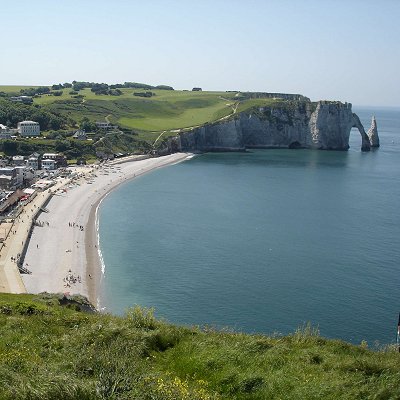
Like us on Facebook
PLACE NAMES


 
|
|
Etretat
|

| |
|
Étretat is a commune in the Seine-Maritime department in Normandie region in north-western France. It is a tourist and farming town situated about 32 km (20 mi) northeast of Le Havre, at the junction of the D 940, D 11 and D 139 roads. It's located on the coast of the Pays de Caux area.
Étretat is best known for its cliffs, including three natural arches and the pointed "needle". These cliffs and the associated resort beach attracted artists including Eugène Boudin, Gustave Courbet and Claude Monet, and were featured prominently in the 1909 Arsène Lupin/Lupin the Third novel The Hollow Needle by Maurice Leblanc.
Two of the three famous arches are seen from the town, the Porte d'Aval, and the Porte d'Amont. The Manneporte is the third and the biggest one, and cannot be seen from the town.
The GR 21 long-distance hiking path (Le Havre to Le Tréport) passes through the town.
Étretat is known for being the last place in France from which the 1927 biplane The White Bird (L'Oiseau Blanc) was seen. French World War I war heroes Charles Nungesser and François Coli were attempting to make the first non-stop flight from Paris to New York City, but after the plane's 8 May 1927 departure, it disappeared somewhere over the Atlantic. It is considered one of the great unexplained mysteries of aviation. A monument to the flight was established in Étretat, but destroyed during World War II, during German occupation. A new and taller monument was constructed in 1963, along with a nearby museum.
 Feel free to Email me any additions or corrections Feel free to Email me any additions or corrections
LINKS AVAILABLE TO YOUR SITE
| | |





